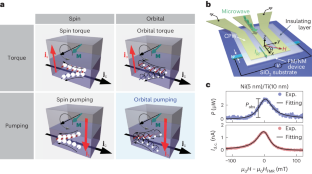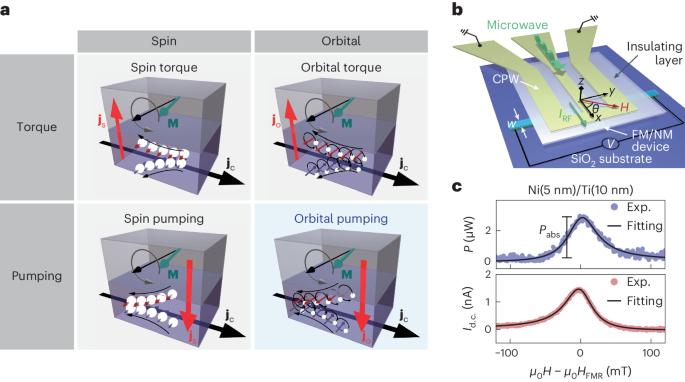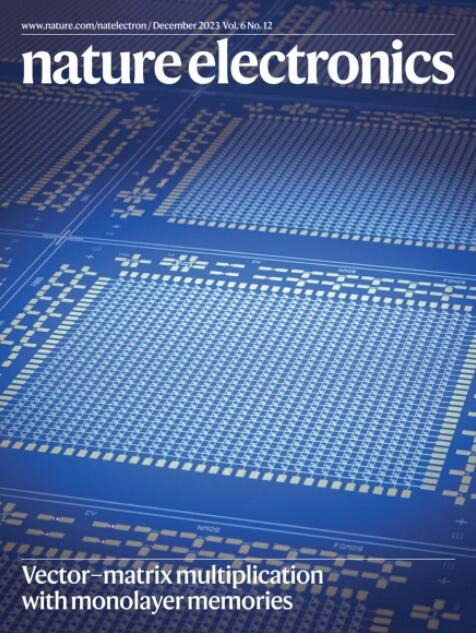观测轨道抽水
IF 33.7
1区 工程技术
Q1 ENGINEERING, ELECTRICAL & ELECTRONIC
引用次数: 0
摘要
电子同时携带自旋和轨道角动量。对产生自旋角动量流现象--自旋电流--的探索推动了自旋电子学的发展。相比之下,自旋电流的轨道对应物--轨道电流--却在很大程度上被忽视了,而且轨道电流的产生仍然具有挑战性。在此,我们报告了从磁化动力学中观察到的轨道电流产生现象:轨道泵。我们表明,镍/钛双层膜中的轨道抽运向钛层注入了轨道电流,我们通过反轨道霍尔效应探测到了这一现象。轨道抽运是自旋抽运的轨道对应物,是自旋电流产生的一种通用而强大的机制。因此,我们的发现为产生轨道电流提供了一种前景广阔的方法,并有助于开发自旋电子学的轨道类似物:轨道电子学。本文章由计算机程序翻译,如有差异,请以英文原文为准。


Observation of orbital pumping
Electrons carry both spin and orbital angular momentum. The search for phenomena that generate a flow of spin angular momentum—a spin current—has led to the development of spintronics. In contrast, the orbital counterpart of spin current—an orbital current—has largely been overlooked, and the generation of an orbital current remains challenging. Here we report the observation of orbital-current generation from magnetization dynamics: orbital pumping. We show that orbital pumping in nickel/titanium bilayers injects an orbital current into the titanium layer, which we detect through the inverse orbital Hall effect. Orbital pumping is the orbital counterpart of spin pumping, a versatile and powerful mechanism for spin-current generation. Our findings could, thus, provide a promising approach for generating orbital currents and could help in the development of the orbital analogue of spintronics: orbitronics. In ferromagnetic/non-magnetic bilayers of nickel/titanium, the precession of magnetization in the nickel layer can inject an orbital current into the titanium layer through orbital pumping, the orbital counterpart of spin pumping.
求助全文
通过发布文献求助,成功后即可免费获取论文全文。
去求助
来源期刊

Nature Electronics
Engineering-Electrical and Electronic Engineering
CiteScore
47.50
自引率
2.30%
发文量
159
期刊介绍:
Nature Electronics is a comprehensive journal that publishes both fundamental and applied research in the field of electronics. It encompasses a wide range of topics, including the study of new phenomena and devices, the design and construction of electronic circuits, and the practical applications of electronics. In addition, the journal explores the commercial and industrial aspects of electronics research.
The primary focus of Nature Electronics is on the development of technology and its potential impact on society. The journal incorporates the contributions of scientists, engineers, and industry professionals, offering a platform for their research findings. Moreover, Nature Electronics provides insightful commentary, thorough reviews, and analysis of the key issues that shape the field, as well as the technologies that are reshaping society.
Like all journals within the prestigious Nature brand, Nature Electronics upholds the highest standards of quality. It maintains a dedicated team of professional editors and follows a fair and rigorous peer-review process. The journal also ensures impeccable copy-editing and production, enabling swift publication. Additionally, Nature Electronics prides itself on its editorial independence, ensuring unbiased and impartial reporting.
In summary, Nature Electronics is a leading journal that publishes cutting-edge research in electronics. With its multidisciplinary approach and commitment to excellence, the journal serves as a valuable resource for scientists, engineers, and industry professionals seeking to stay at the forefront of advancements in the field.
 求助内容:
求助内容: 应助结果提醒方式:
应助结果提醒方式:


